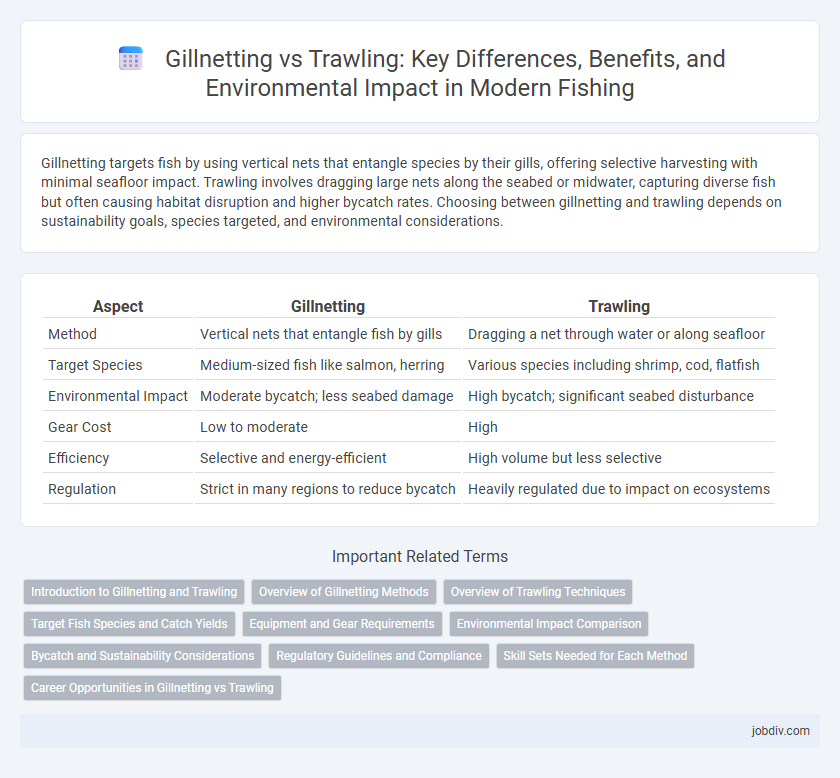Gillnetting targets fish by using vertical nets that entangle species by their gills, offering selective harvesting with minimal seafloor impact. Trawling involves dragging large nets along the seabed or midwater, capturing diverse fish but often causing habitat disruption and higher bycatch rates. Choosing between gillnetting and trawling depends on sustainability goals, species targeted, and environmental considerations.
Table of Comparison
| Aspect | Gillnetting | Trawling |
|---|---|---|
| Method | Vertical nets that entangle fish by gills | Dragging a net through water or along seafloor |
| Target Species | Medium-sized fish like salmon, herring | Various species including shrimp, cod, flatfish |
| Environmental Impact | Moderate bycatch; less seabed damage | High bycatch; significant seabed disturbance |
| Gear Cost | Low to moderate | High |
| Efficiency | Selective and energy-efficient | High volume but less selective |
| Regulation | Strict in many regions to reduce bycatch | Heavily regulated due to impact on ecosystems |
Introduction to Gillnetting and Trawling
Gillnetting employs vertical nets that hang like curtains in the water, capturing fish by their gills as they swim into the mesh, making it effective for targeting specific fish sizes and species. Trawling involves pulling a large net, either along the sea floor (bottom trawling) or in midwater (pelagic trawling), capturing a wide range of fish and bycatch due to its extensive sweep. Both methods vary in environmental impact, with gillnetting generally causing less seabed disturbance than bottom trawling but posing significant risks to non-target marine life.
Overview of Gillnetting Methods
Gillnetting involves deploying vertical panels of netting that entangle fish by their gills, commonly targeting species like salmon, cod, and herring. These nets vary in mesh size and length to selectively capture specific fish sizes and minimize bycatch. This method offers a passive, energy-efficient fishing approach with lower habitat impact compared to trawling.
Overview of Trawling Techniques
Trawling involves dragging a large net, known as a trawl, through the water column or along the sea floor to catch fish and other marine species. Common types include bottom trawling, targeting demersal fish by sweeping the seabed, and midwater trawling, which captures pelagic species swimming in open water. This method is efficient for large-scale fishing but raises concerns about bycatch and habitat disturbance.
Target Fish Species and Catch Yields
Gillnetting primarily targets mid-sized, schooling fish such as salmon, herring, and cod, enabling selective harvesting with lower bycatch rates. Trawling is more versatile in catch yields, capturing a wide range of demersal and pelagic species like shrimp, flounder, and pollock but often results in higher bycatch and habitat disturbance. Catch yields from trawling tend to be larger and more continuous, while gillnetting delivers more species-specific and sustainable results.
Equipment and Gear Requirements
Gillnetting requires vertical panels of netting with specific mesh sizes to capture fish by entangling them, often supported by floats and weights to maintain position, making it suitable for coastal and shallow waters. Trawling demands a robust trawl net, typically cone-shaped, attached to trawl doors and towed behind a boat, requiring powerful winches and a sturdy vessel to handle heavy gear and maintain consistent speed. The specialized equipment for each method reflects their operational environments and target species, influencing setup complexity and maintenance needs.
Environmental Impact Comparison
Gillnetting typically results in lower habitat destruction compared to trawling, as it involves stationary nets that minimize seabed disturbance. Trawling often causes extensive damage to benthic ecosystems due to the dragging of heavy nets across the ocean floor, leading to significant loss of biodiversity. Moreover, gillnetting tends to have a higher rate of bycatch reduction, which helps protect non-target species and supports more sustainable fishing practices.
Bycatch and Sustainability Considerations
Gillnetting often results in high bycatch rates, entangling non-target species such as dolphins, turtles, and seabirds, which raises significant sustainability concerns. Trawling, particularly bottom trawling, causes extensive habitat destruction and captures large quantities of unintended marine life, contributing to ecosystem degradation. Sustainable fisheries prioritize selective gear types and bycatch reduction technologies to minimize ecological impacts and support marine biodiversity conservation.
Regulatory Guidelines and Compliance
Gillnetting and trawling are subject to distinct regulatory guidelines to minimize environmental impact and ensure sustainable fishing practices. Gillnetting regulations often include mesh size restrictions and seasonal closures to protect juvenile fish and non-target species, while trawling regulations focus on gear modifications, bycatch reduction devices, and designated trawling zones to prevent habitat destruction. Compliance with these rules is enforced through monitoring systems such as vessel tracking, observer programs, and regular inspections to promote responsible fisheries management.
Skill Sets Needed for Each Method
Gillnetting requires precise knowledge of fish behavior and habitat to set nets effectively and avoid bycatch, alongside skills in net repair and navigation. Trawling demands expertise in vessel operation, sonar technology, and understanding seabed topography to manage heavy equipment and minimize environmental impact. Both methods necessitate safety training and regulatory compliance but differ sharply in technical complexity and ecological awareness.
Career Opportunities in Gillnetting vs Trawling
Gillnetting offers specialized career opportunities focused on selective fishing techniques, often requiring skills in net management and species identification. Trawling careers emphasize operating large vessels with heavy gear, demanding expertise in navigation, machinery maintenance, and catch processing. Both fields provide employment in commercial fishing but differ significantly in work environment, skill sets, and safety considerations.
Gillnetting vs Trawling Infographic

 jobdiv.com
jobdiv.com